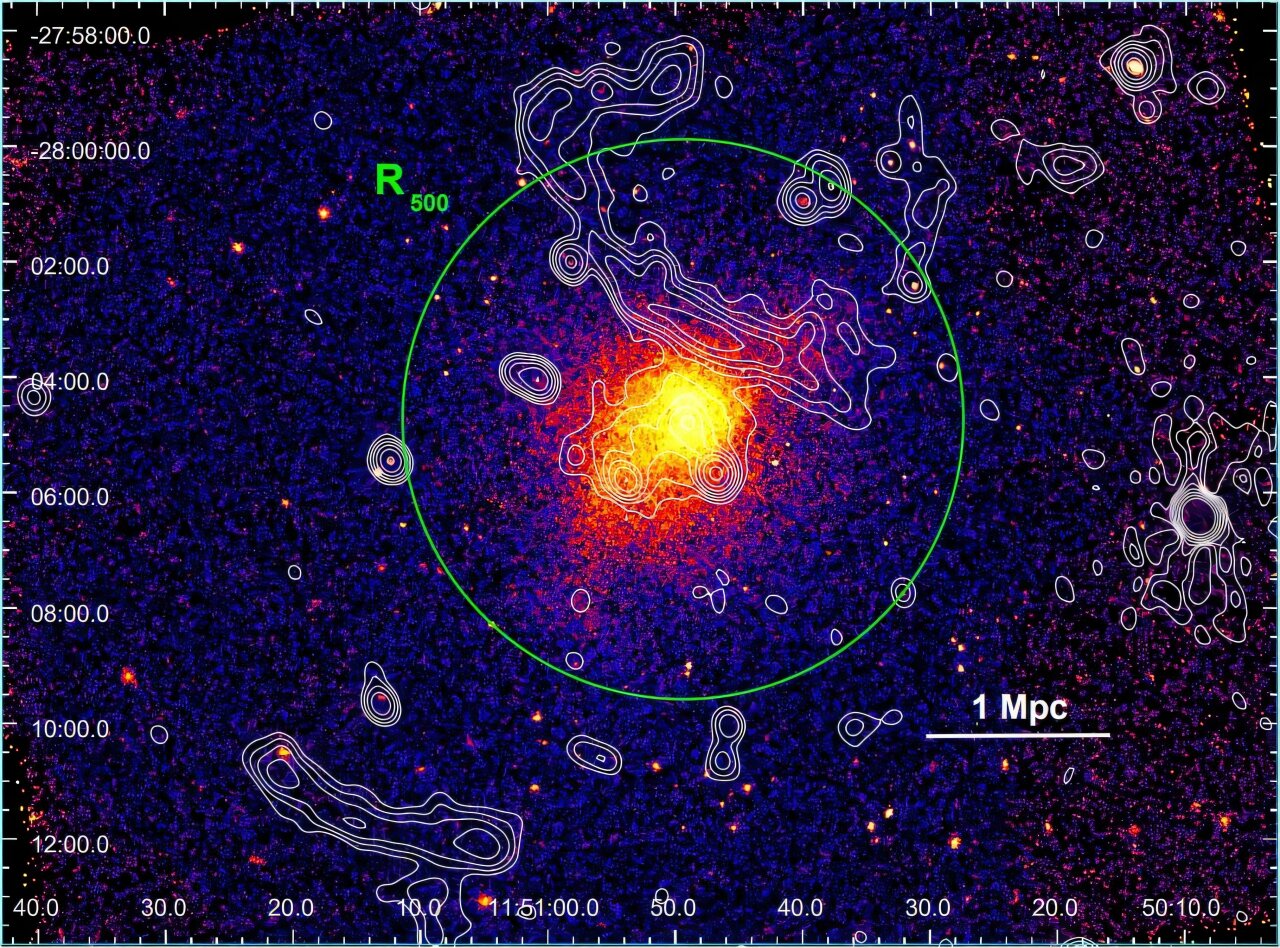Using NASA’s Chandra X-ray Observatory, astronomers have conducted an in-depth study of a massive and hot galaxy cluster known as PLCKG287.0+32.9 (PLCKG287). The new observations provide crucial insights into the cluster’s structure, thermodynamics, and dynamic state, shedding light on the powerful forces at play in galaxy mergers.
A Colossal Galaxy Cluster in the Cosmos
PLCKG287, also cataloged as PSZ2 G286.98+32.90, is located at a redshift of 0.38, meaning its light has traveled billions of years to reach Earth. With a staggering mass of about 1.37 quadrillion times that of the Sun and a temperature of approximately 13 keV, this galaxy cluster ranks among the most extreme environments in the universe. Its immense gravitational pull binds together thousands of galaxies, along with vast amounts of hot gas and dark matter.
Galaxy clusters like PLCKG287 are the largest gravitationally bound structures in the universe, formed through cosmic collisions and mergers of smaller clusters. These events release enormous amounts of energy, making them prime targets for studying the nature of dark matter, cosmic rays, and the physical processes shaping large-scale cosmic structures.
Mysterious Radio Relics and a Turbulent History
Previous studies of PLCKG287 revealed that it hosts two symmetrical radio relics—structures formed by merger-driven shock waves that accelerate cosmic ray electrons to near-light speeds. The cluster also contains a diffuse radio halo, thought to result from turbulent motions re-energizing cosmic rays within the intra-cluster medium. These features indicate that PLCKG287 is undergoing an active merger, with its main axis stretching from the northwest to the southeast.
Recognizing its unique properties, a team of astronomers led by Myriam Gitti of the University of Bologna in Italy conducted a detailed X-ray analysis using Chandra’s Advanced CCD Imaging Spectrometer (ACIS). Their goal was to uncover the internal dynamics of the cluster and understand how ongoing mergers and energetic feedback mechanisms shape its evolution.
X-ray Observations Reveal a Disturbed Structure
The Chandra data revealed a striking comet-like X-ray morphology in PLCKG287, aligned with the cluster’s northwest-southeast orientation. A bright X-ray core was observed, coinciding with the known giant radio halo. However, a significant spatial offset—measuring about 260,000 light-years—was detected between the X-ray peak and the cluster’s brightest central galaxy (BCG). This displacement strongly suggests that the cluster is in a highly disturbed state, likely the result of recent or ongoing merger activity.
Analyzing the central 4.9 million light-years of PLCKG287, astronomers determined its global temperature to be approximately 12.73 keV. Its X-ray luminosity in the 2–10 keV energy band measured around 1.09 quattuordecillion ergs per second, confirming its status as an extremely hot and luminous system. The gas mass in the cluster was found to be about 0.16 quadrillion solar masses, while the total cluster mass was estimated at 1.2 quadrillion solar masses.
Shocking Discoveries: Evidence of Merger Activity
One of the most intriguing findings from the Chandra observations was the detection of a powerful shock front located about 1.27 million light-years northwest of the cluster’s center. This shock, moving at approximately 2,100 km/s, displayed a density jump of 1.43 and a Mach number of 1.29, indicating that PLCKG287 is still in the midst of a dramatic merger event.
Further analysis revealed a cold front in the same direction, situated roughly 962,000 light-years from the cluster center. This feature, characterized by a density jump of 1.44, is a direct result of the violent interplay between merging sub-clusters, where cooler gas is displaced and compressed by surrounding hotter material.
A Reheated Core and the Role of Active Galactic Nucleus Feedback
The presence of both a shock front and a cold front in PLCKG287 suggests that its core has undergone significant heating, likely due to a combination of merger activity and feedback from an active galactic nucleus (AGN). The study’s authors propose that the cluster originally hosted a cool core, which was later reheated by energy injected from AGN activity and large-scale mergers. This process could explain the observed high temperatures in the central region, as well as the presence of complex structures in the X-ray emission.
The findings from this study highlight the dynamic nature of PLCKG287 and reinforce the importance of galaxy clusters as laboratories for studying extreme physical processes. Merging clusters provide key insights into the behavior of dark matter, the physics of shock waves, and the mechanisms that drive cosmic ray acceleration.
Unlocking the Mysteries of the Universe
The detailed analysis of PLCKG287 with Chandra’s X-ray vision has revealed a turbulent, high-energy environment shaped by cosmic collisions and feedback mechanisms. By studying such clusters, astronomers continue to unravel the mysteries of the universe’s largest structures, gaining a deeper understanding of how galaxies evolve and interact on cosmic timescales.
Future observations with next-generation telescopes, including the upcoming Lynx X-ray Observatory and radio surveys with the Square Kilometer Array (SKA), will provide even more detailed views of galaxy clusters like PLCKG287. As technology advances, scientists will be able to probe deeper into the universe’s most extreme environments, unlocking new secrets about the forces that shape the cosmos.
Reference: M. Gitti et al, Deep Chandra observations of PLCKG287.0+32.9: a clear detection of a shock front in a heated former cool core, arXiv (2025). DOI: 10.48550/arxiv.2503.13735
